Capstone Project on Culturally Sensitive Communication in Healthcare
VerifiedAdded on 2022/08/24
|9
|2284
|26
Project
AI Summary
This capstone project delves into the critical importance of culturally sensitive communication within the healthcare system. It begins by defining cultural competency and its impact on patient outcomes, emphasizing the role of effective communication in fostering positive nurse-patient relationships and reducing health disparities. The project identifies communication barriers, particularly language differences, as a significant challenge, tracing the historical context of the problem from early migration patterns to present-day socio-economic disparities. The project analyzes the current scope of the problem, highlighting the significance of culturally sensitive communication in promoting patient satisfaction and improving treatment outcomes. It also discusses current strategies, such as the LEARN model and educational programs, aimed at addressing communication challenges. The project concludes by summarizing the key issues and emphasizing the need for continued efforts to improve cultural sensitivity in healthcare, while also acknowledging the barriers to implementation, such as cost and access to care. The project provides a comprehensive overview of the challenges and opportunities in this area, offering valuable insights for healthcare professionals and researchers.
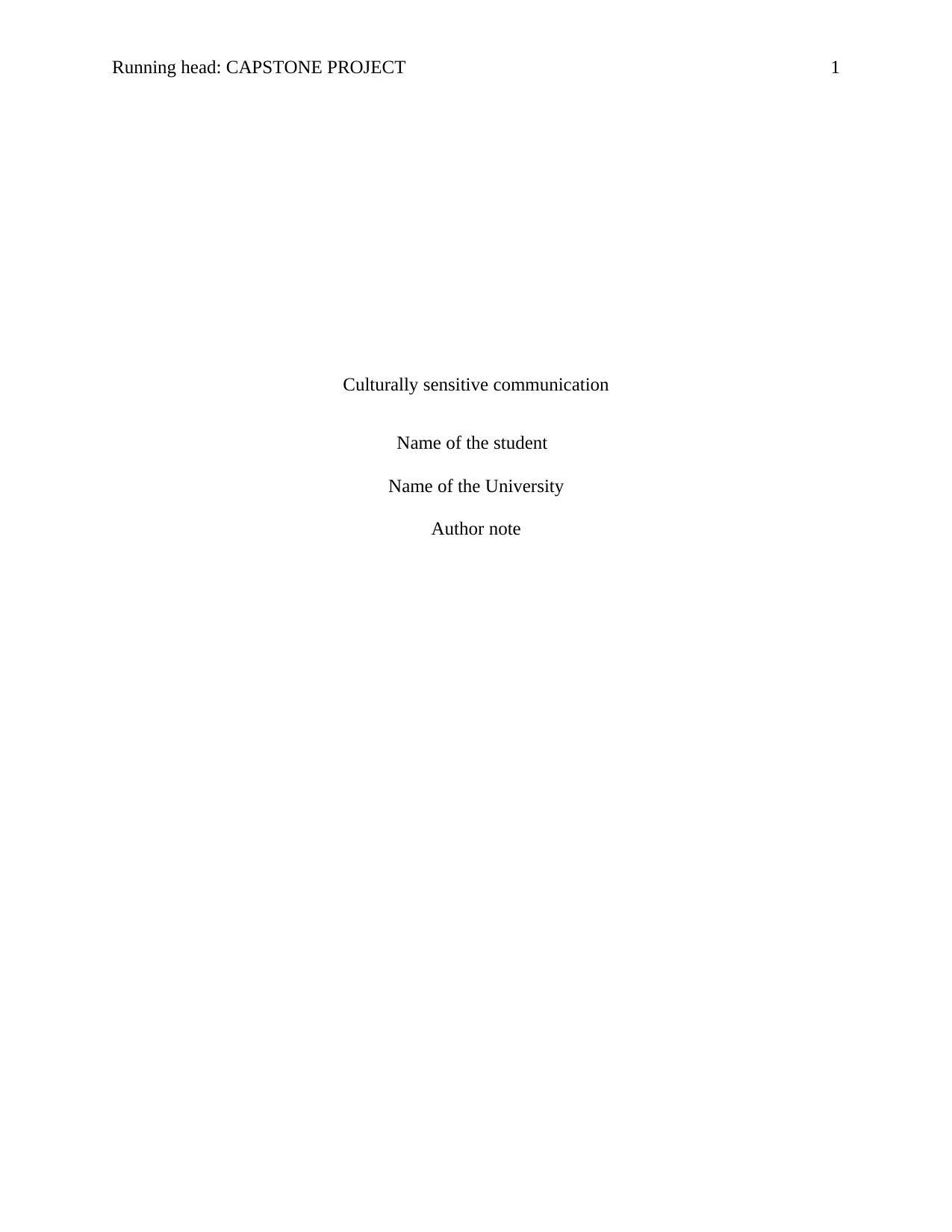
Running head: CAPSTONE PROJECT 1
Culturally sensitive communication
Name of the student
Name of the University
Author note
Culturally sensitive communication
Name of the student
Name of the University
Author note
Paraphrase This Document
Need a fresh take? Get an instant paraphrase of this document with our AI Paraphraser
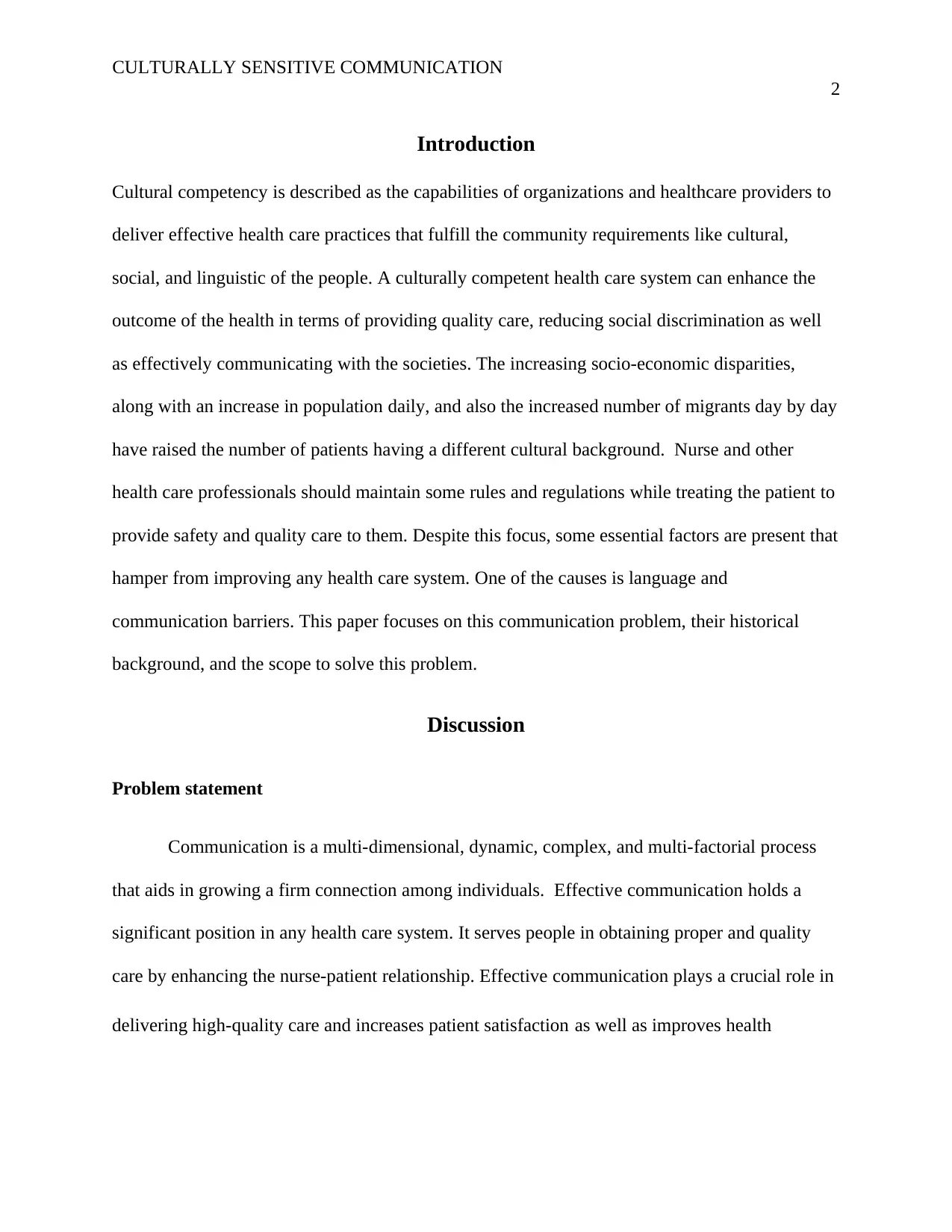
CULTURALLY SENSITIVE COMMUNICATION
2
Introduction
Cultural competency is described as the capabilities of organizations and healthcare providers to
deliver effective health care practices that fulfill the community requirements like cultural,
social, and linguistic of the people. A culturally competent health care system can enhance the
outcome of the health in terms of providing quality care, reducing social discrimination as well
as effectively communicating with the societies. The increasing socio-economic disparities,
along with an increase in population daily, and also the increased number of migrants day by day
have raised the number of patients having a different cultural background. Nurse and other
health care professionals should maintain some rules and regulations while treating the patient to
provide safety and quality care to them. Despite this focus, some essential factors are present that
hamper from improving any health care system. One of the causes is language and
communication barriers. This paper focuses on this communication problem, their historical
background, and the scope to solve this problem.
Discussion
Problem statement
Communication is a multi-dimensional, dynamic, complex, and multi-factorial process
that aids in growing a firm connection among individuals. Effective communication holds a
significant position in any health care system. It serves people in obtaining proper and quality
care by enhancing the nurse-patient relationship. Effective communication plays a crucial role in
delivering high-quality care and increases patient satisfaction as well as improves health
2
Introduction
Cultural competency is described as the capabilities of organizations and healthcare providers to
deliver effective health care practices that fulfill the community requirements like cultural,
social, and linguistic of the people. A culturally competent health care system can enhance the
outcome of the health in terms of providing quality care, reducing social discrimination as well
as effectively communicating with the societies. The increasing socio-economic disparities,
along with an increase in population daily, and also the increased number of migrants day by day
have raised the number of patients having a different cultural background. Nurse and other
health care professionals should maintain some rules and regulations while treating the patient to
provide safety and quality care to them. Despite this focus, some essential factors are present that
hamper from improving any health care system. One of the causes is language and
communication barriers. This paper focuses on this communication problem, their historical
background, and the scope to solve this problem.
Discussion
Problem statement
Communication is a multi-dimensional, dynamic, complex, and multi-factorial process
that aids in growing a firm connection among individuals. Effective communication holds a
significant position in any health care system. It serves people in obtaining proper and quality
care by enhancing the nurse-patient relationship. Effective communication plays a crucial role in
delivering high-quality care and increases patient satisfaction as well as improves health
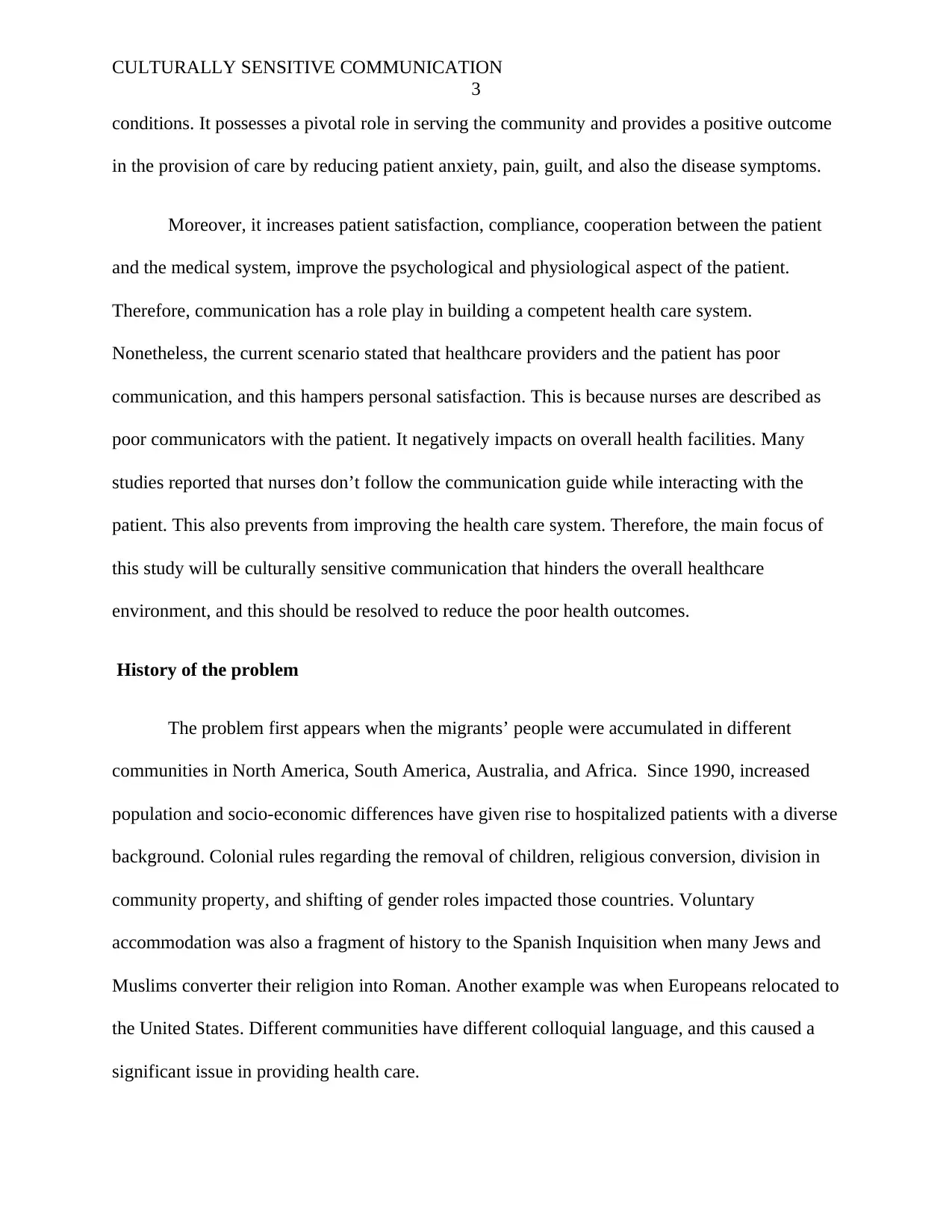
CULTURALLY SENSITIVE COMMUNICATION
3
conditions. It possesses a pivotal role in serving the community and provides a positive outcome
in the provision of care by reducing patient anxiety, pain, guilt, and also the disease symptoms.
Moreover, it increases patient satisfaction, compliance, cooperation between the patient
and the medical system, improve the psychological and physiological aspect of the patient.
Therefore, communication has a role play in building a competent health care system.
Nonetheless, the current scenario stated that healthcare providers and the patient has poor
communication, and this hampers personal satisfaction. This is because nurses are described as
poor communicators with the patient. It negatively impacts on overall health facilities. Many
studies reported that nurses don’t follow the communication guide while interacting with the
patient. This also prevents from improving the health care system. Therefore, the main focus of
this study will be culturally sensitive communication that hinders the overall healthcare
environment, and this should be resolved to reduce the poor health outcomes.
History of the problem
The problem first appears when the migrants’ people were accumulated in different
communities in North America, South America, Australia, and Africa. Since 1990, increased
population and socio-economic differences have given rise to hospitalized patients with a diverse
background. Colonial rules regarding the removal of children, religious conversion, division in
community property, and shifting of gender roles impacted those countries. Voluntary
accommodation was also a fragment of history to the Spanish Inquisition when many Jews and
Muslims converter their religion into Roman. Another example was when Europeans relocated to
the United States. Different communities have different colloquial language, and this caused a
significant issue in providing health care.
3
conditions. It possesses a pivotal role in serving the community and provides a positive outcome
in the provision of care by reducing patient anxiety, pain, guilt, and also the disease symptoms.
Moreover, it increases patient satisfaction, compliance, cooperation between the patient
and the medical system, improve the psychological and physiological aspect of the patient.
Therefore, communication has a role play in building a competent health care system.
Nonetheless, the current scenario stated that healthcare providers and the patient has poor
communication, and this hampers personal satisfaction. This is because nurses are described as
poor communicators with the patient. It negatively impacts on overall health facilities. Many
studies reported that nurses don’t follow the communication guide while interacting with the
patient. This also prevents from improving the health care system. Therefore, the main focus of
this study will be culturally sensitive communication that hinders the overall healthcare
environment, and this should be resolved to reduce the poor health outcomes.
History of the problem
The problem first appears when the migrants’ people were accumulated in different
communities in North America, South America, Australia, and Africa. Since 1990, increased
population and socio-economic differences have given rise to hospitalized patients with a diverse
background. Colonial rules regarding the removal of children, religious conversion, division in
community property, and shifting of gender roles impacted those countries. Voluntary
accommodation was also a fragment of history to the Spanish Inquisition when many Jews and
Muslims converter their religion into Roman. Another example was when Europeans relocated to
the United States. Different communities have different colloquial language, and this caused a
significant issue in providing health care.
⊘ This is a preview!⊘
Do you want full access?
Subscribe today to unlock all pages.

Trusted by 1+ million students worldwide
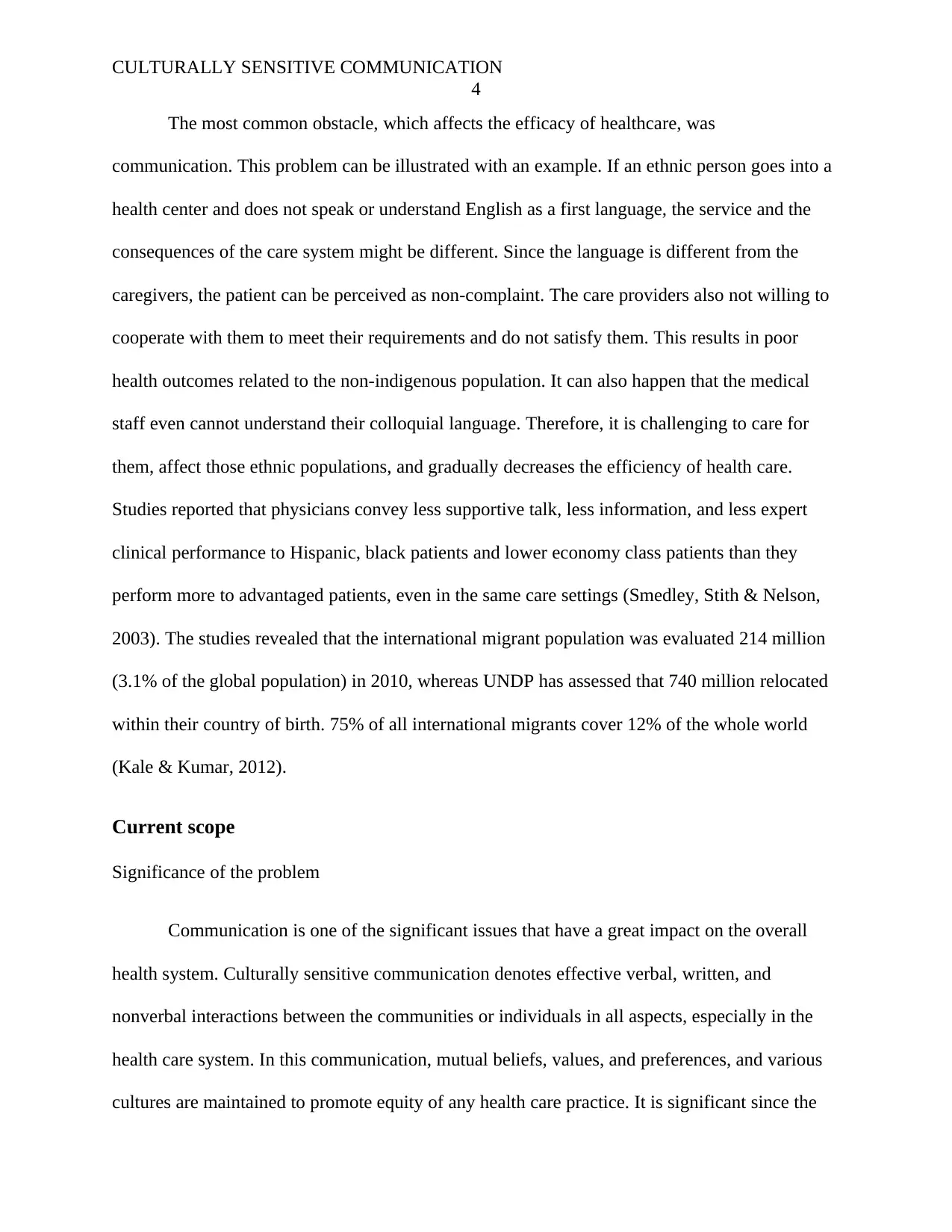
CULTURALLY SENSITIVE COMMUNICATION
4
The most common obstacle, which affects the efficacy of healthcare, was
communication. This problem can be illustrated with an example. If an ethnic person goes into a
health center and does not speak or understand English as a first language, the service and the
consequences of the care system might be different. Since the language is different from the
caregivers, the patient can be perceived as non-complaint. The care providers also not willing to
cooperate with them to meet their requirements and do not satisfy them. This results in poor
health outcomes related to the non-indigenous population. It can also happen that the medical
staff even cannot understand their colloquial language. Therefore, it is challenging to care for
them, affect those ethnic populations, and gradually decreases the efficiency of health care.
Studies reported that physicians convey less supportive talk, less information, and less expert
clinical performance to Hispanic, black patients and lower economy class patients than they
perform more to advantaged patients, even in the same care settings (Smedley, Stith & Nelson,
2003). The studies revealed that the international migrant population was evaluated 214 million
(3.1% of the global population) in 2010, whereas UNDP has assessed that 740 million relocated
within their country of birth. 75% of all international migrants cover 12% of the whole world
(Kale & Kumar, 2012).
Current scope
Significance of the problem
Communication is one of the significant issues that have a great impact on the overall
health system. Culturally sensitive communication denotes effective verbal, written, and
nonverbal interactions between the communities or individuals in all aspects, especially in the
health care system. In this communication, mutual beliefs, values, and preferences, and various
cultures are maintained to promote equity of any health care practice. It is significant since the
4
The most common obstacle, which affects the efficacy of healthcare, was
communication. This problem can be illustrated with an example. If an ethnic person goes into a
health center and does not speak or understand English as a first language, the service and the
consequences of the care system might be different. Since the language is different from the
caregivers, the patient can be perceived as non-complaint. The care providers also not willing to
cooperate with them to meet their requirements and do not satisfy them. This results in poor
health outcomes related to the non-indigenous population. It can also happen that the medical
staff even cannot understand their colloquial language. Therefore, it is challenging to care for
them, affect those ethnic populations, and gradually decreases the efficiency of health care.
Studies reported that physicians convey less supportive talk, less information, and less expert
clinical performance to Hispanic, black patients and lower economy class patients than they
perform more to advantaged patients, even in the same care settings (Smedley, Stith & Nelson,
2003). The studies revealed that the international migrant population was evaluated 214 million
(3.1% of the global population) in 2010, whereas UNDP has assessed that 740 million relocated
within their country of birth. 75% of all international migrants cover 12% of the whole world
(Kale & Kumar, 2012).
Current scope
Significance of the problem
Communication is one of the significant issues that have a great impact on the overall
health system. Culturally sensitive communication denotes effective verbal, written, and
nonverbal interactions between the communities or individuals in all aspects, especially in the
health care system. In this communication, mutual beliefs, values, and preferences, and various
cultures are maintained to promote equity of any health care practice. It is significant since the
Paraphrase This Document
Need a fresh take? Get an instant paraphrase of this document with our AI Paraphraser
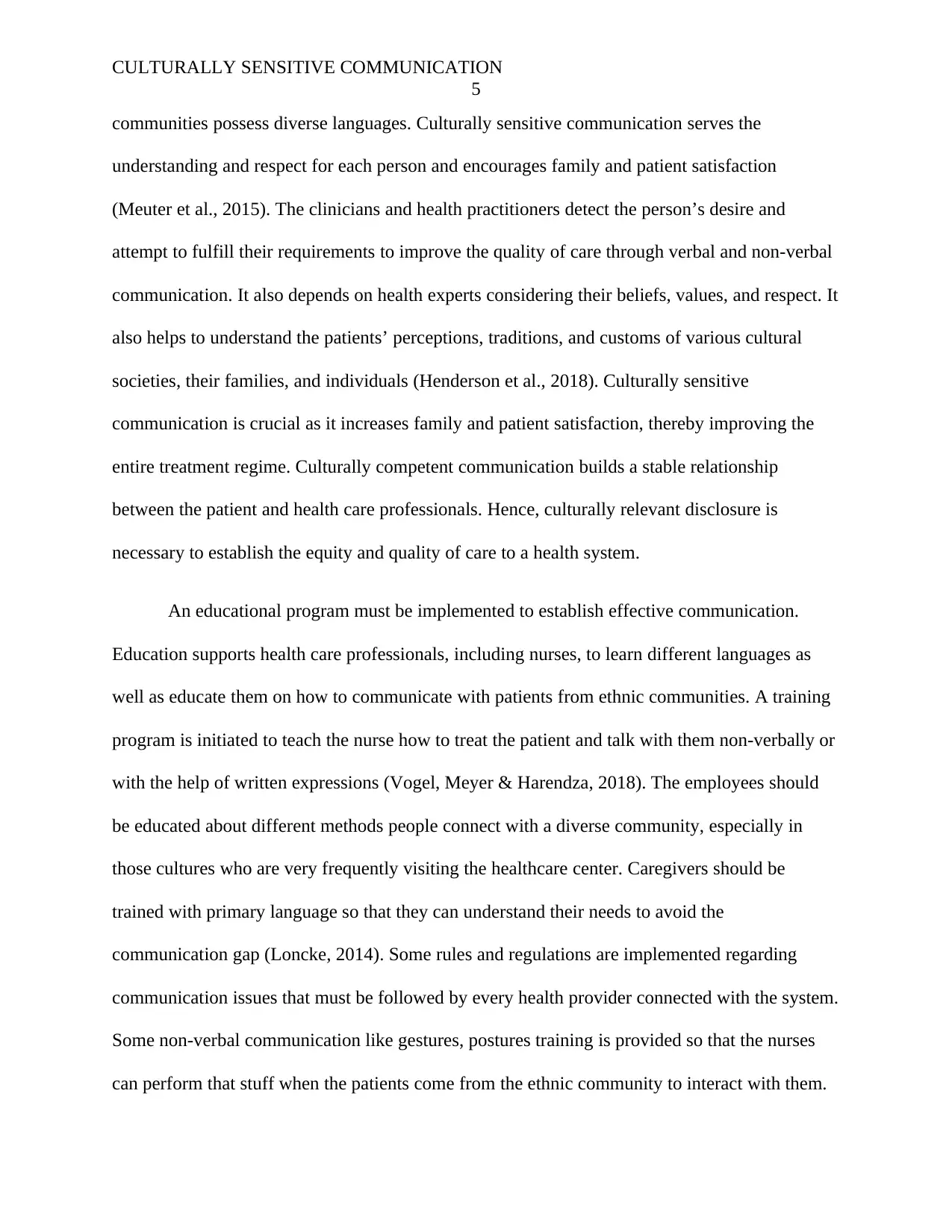
CULTURALLY SENSITIVE COMMUNICATION
5
communities possess diverse languages. Culturally sensitive communication serves the
understanding and respect for each person and encourages family and patient satisfaction
(Meuter et al., 2015). The clinicians and health practitioners detect the person’s desire and
attempt to fulfill their requirements to improve the quality of care through verbal and non-verbal
communication. It also depends on health experts considering their beliefs, values, and respect. It
also helps to understand the patients’ perceptions, traditions, and customs of various cultural
societies, their families, and individuals (Henderson et al., 2018). Culturally sensitive
communication is crucial as it increases family and patient satisfaction, thereby improving the
entire treatment regime. Culturally competent communication builds a stable relationship
between the patient and health care professionals. Hence, culturally relevant disclosure is
necessary to establish the equity and quality of care to a health system.
An educational program must be implemented to establish effective communication.
Education supports health care professionals, including nurses, to learn different languages as
well as educate them on how to communicate with patients from ethnic communities. A training
program is initiated to teach the nurse how to treat the patient and talk with them non-verbally or
with the help of written expressions (Vogel, Meyer & Harendza, 2018). The employees should
be educated about different methods people connect with a diverse community, especially in
those cultures who are very frequently visiting the healthcare center. Caregivers should be
trained with primary language so that they can understand their needs to avoid the
communication gap (Loncke, 2014). Some rules and regulations are implemented regarding
communication issues that must be followed by every health provider connected with the system.
Some non-verbal communication like gestures, postures training is provided so that the nurses
can perform that stuff when the patients come from the ethnic community to interact with them.
5
communities possess diverse languages. Culturally sensitive communication serves the
understanding and respect for each person and encourages family and patient satisfaction
(Meuter et al., 2015). The clinicians and health practitioners detect the person’s desire and
attempt to fulfill their requirements to improve the quality of care through verbal and non-verbal
communication. It also depends on health experts considering their beliefs, values, and respect. It
also helps to understand the patients’ perceptions, traditions, and customs of various cultural
societies, their families, and individuals (Henderson et al., 2018). Culturally sensitive
communication is crucial as it increases family and patient satisfaction, thereby improving the
entire treatment regime. Culturally competent communication builds a stable relationship
between the patient and health care professionals. Hence, culturally relevant disclosure is
necessary to establish the equity and quality of care to a health system.
An educational program must be implemented to establish effective communication.
Education supports health care professionals, including nurses, to learn different languages as
well as educate them on how to communicate with patients from ethnic communities. A training
program is initiated to teach the nurse how to treat the patient and talk with them non-verbally or
with the help of written expressions (Vogel, Meyer & Harendza, 2018). The employees should
be educated about different methods people connect with a diverse community, especially in
those cultures who are very frequently visiting the healthcare center. Caregivers should be
trained with primary language so that they can understand their needs to avoid the
communication gap (Loncke, 2014). Some rules and regulations are implemented regarding
communication issues that must be followed by every health provider connected with the system.
Some non-verbal communication like gestures, postures training is provided so that the nurses
can perform that stuff when the patients come from the ethnic community to interact with them.
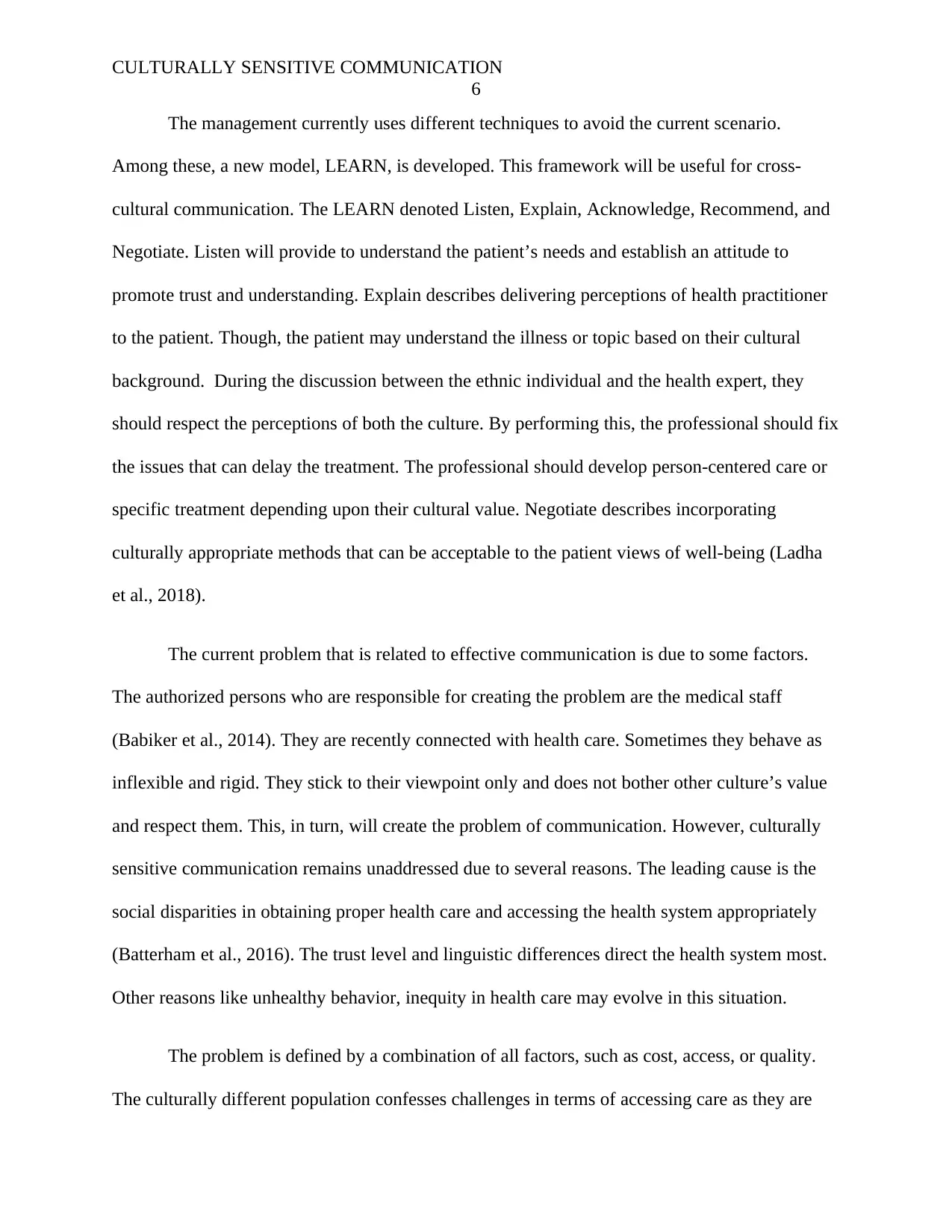
CULTURALLY SENSITIVE COMMUNICATION
6
The management currently uses different techniques to avoid the current scenario.
Among these, a new model, LEARN, is developed. This framework will be useful for cross-
cultural communication. The LEARN denoted Listen, Explain, Acknowledge, Recommend, and
Negotiate. Listen will provide to understand the patient’s needs and establish an attitude to
promote trust and understanding. Explain describes delivering perceptions of health practitioner
to the patient. Though, the patient may understand the illness or topic based on their cultural
background. During the discussion between the ethnic individual and the health expert, they
should respect the perceptions of both the culture. By performing this, the professional should fix
the issues that can delay the treatment. The professional should develop person-centered care or
specific treatment depending upon their cultural value. Negotiate describes incorporating
culturally appropriate methods that can be acceptable to the patient views of well-being (Ladha
et al., 2018).
The current problem that is related to effective communication is due to some factors.
The authorized persons who are responsible for creating the problem are the medical staff
(Babiker et al., 2014). They are recently connected with health care. Sometimes they behave as
inflexible and rigid. They stick to their viewpoint only and does not bother other culture’s value
and respect them. This, in turn, will create the problem of communication. However, culturally
sensitive communication remains unaddressed due to several reasons. The leading cause is the
social disparities in obtaining proper health care and accessing the health system appropriately
(Batterham et al., 2016). The trust level and linguistic differences direct the health system most.
Other reasons like unhealthy behavior, inequity in health care may evolve in this situation.
The problem is defined by a combination of all factors, such as cost, access, or quality.
The culturally different population confesses challenges in terms of accessing care as they are
6
The management currently uses different techniques to avoid the current scenario.
Among these, a new model, LEARN, is developed. This framework will be useful for cross-
cultural communication. The LEARN denoted Listen, Explain, Acknowledge, Recommend, and
Negotiate. Listen will provide to understand the patient’s needs and establish an attitude to
promote trust and understanding. Explain describes delivering perceptions of health practitioner
to the patient. Though, the patient may understand the illness or topic based on their cultural
background. During the discussion between the ethnic individual and the health expert, they
should respect the perceptions of both the culture. By performing this, the professional should fix
the issues that can delay the treatment. The professional should develop person-centered care or
specific treatment depending upon their cultural value. Negotiate describes incorporating
culturally appropriate methods that can be acceptable to the patient views of well-being (Ladha
et al., 2018).
The current problem that is related to effective communication is due to some factors.
The authorized persons who are responsible for creating the problem are the medical staff
(Babiker et al., 2014). They are recently connected with health care. Sometimes they behave as
inflexible and rigid. They stick to their viewpoint only and does not bother other culture’s value
and respect them. This, in turn, will create the problem of communication. However, culturally
sensitive communication remains unaddressed due to several reasons. The leading cause is the
social disparities in obtaining proper health care and accessing the health system appropriately
(Batterham et al., 2016). The trust level and linguistic differences direct the health system most.
Other reasons like unhealthy behavior, inequity in health care may evolve in this situation.
The problem is defined by a combination of all factors, such as cost, access, or quality.
The culturally different population confesses challenges in terms of accessing care as they are
⊘ This is a preview!⊘
Do you want full access?
Subscribe today to unlock all pages.

Trusted by 1+ million students worldwide
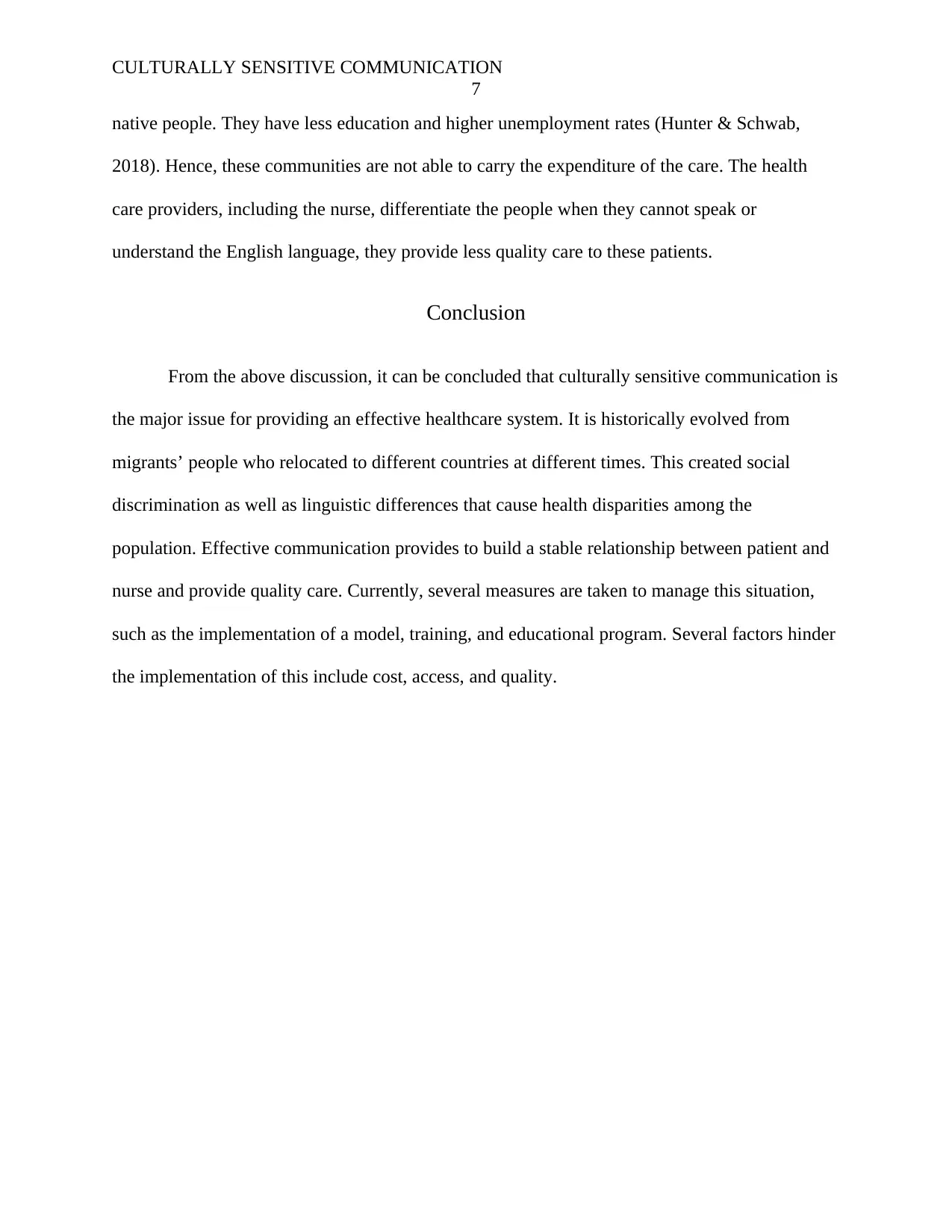
CULTURALLY SENSITIVE COMMUNICATION
7
native people. They have less education and higher unemployment rates (Hunter & Schwab,
2018). Hence, these communities are not able to carry the expenditure of the care. The health
care providers, including the nurse, differentiate the people when they cannot speak or
understand the English language, they provide less quality care to these patients.
Conclusion
From the above discussion, it can be concluded that culturally sensitive communication is
the major issue for providing an effective healthcare system. It is historically evolved from
migrants’ people who relocated to different countries at different times. This created social
discrimination as well as linguistic differences that cause health disparities among the
population. Effective communication provides to build a stable relationship between patient and
nurse and provide quality care. Currently, several measures are taken to manage this situation,
such as the implementation of a model, training, and educational program. Several factors hinder
the implementation of this include cost, access, and quality.
7
native people. They have less education and higher unemployment rates (Hunter & Schwab,
2018). Hence, these communities are not able to carry the expenditure of the care. The health
care providers, including the nurse, differentiate the people when they cannot speak or
understand the English language, they provide less quality care to these patients.
Conclusion
From the above discussion, it can be concluded that culturally sensitive communication is
the major issue for providing an effective healthcare system. It is historically evolved from
migrants’ people who relocated to different countries at different times. This created social
discrimination as well as linguistic differences that cause health disparities among the
population. Effective communication provides to build a stable relationship between patient and
nurse and provide quality care. Currently, several measures are taken to manage this situation,
such as the implementation of a model, training, and educational program. Several factors hinder
the implementation of this include cost, access, and quality.
Paraphrase This Document
Need a fresh take? Get an instant paraphrase of this document with our AI Paraphraser
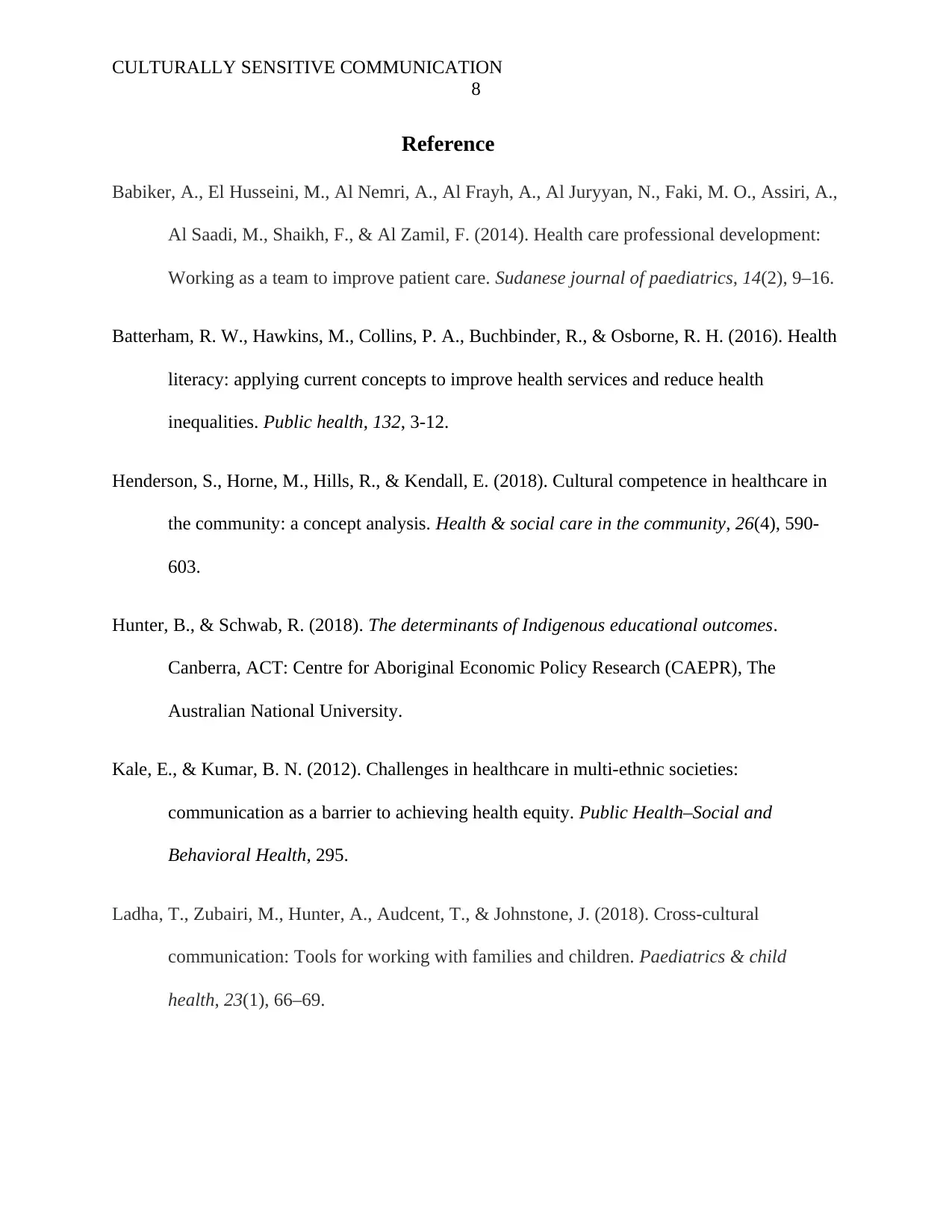
CULTURALLY SENSITIVE COMMUNICATION
8
Reference
Babiker, A., El Husseini, M., Al Nemri, A., Al Frayh, A., Al Juryyan, N., Faki, M. O., Assiri, A.,
Al Saadi, M., Shaikh, F., & Al Zamil, F. (2014). Health care professional development:
Working as a team to improve patient care. Sudanese journal of paediatrics, 14(2), 9–16.
Batterham, R. W., Hawkins, M., Collins, P. A., Buchbinder, R., & Osborne, R. H. (2016). Health
literacy: applying current concepts to improve health services and reduce health
inequalities. Public health, 132, 3-12.
Henderson, S., Horne, M., Hills, R., & Kendall, E. (2018). Cultural competence in healthcare in
the community: a concept analysis. Health & social care in the community, 26(4), 590-
603.
Hunter, B., & Schwab, R. (2018). The determinants of Indigenous educational outcomes.
Canberra, ACT: Centre for Aboriginal Economic Policy Research (CAEPR), The
Australian National University.
Kale, E., & Kumar, B. N. (2012). Challenges in healthcare in multi-ethnic societies:
communication as a barrier to achieving health equity. Public Health–Social and
Behavioral Health, 295.
Ladha, T., Zubairi, M., Hunter, A., Audcent, T., & Johnstone, J. (2018). Cross-cultural
communication: Tools for working with families and children. Paediatrics & child
health, 23(1), 66–69.
8
Reference
Babiker, A., El Husseini, M., Al Nemri, A., Al Frayh, A., Al Juryyan, N., Faki, M. O., Assiri, A.,
Al Saadi, M., Shaikh, F., & Al Zamil, F. (2014). Health care professional development:
Working as a team to improve patient care. Sudanese journal of paediatrics, 14(2), 9–16.
Batterham, R. W., Hawkins, M., Collins, P. A., Buchbinder, R., & Osborne, R. H. (2016). Health
literacy: applying current concepts to improve health services and reduce health
inequalities. Public health, 132, 3-12.
Henderson, S., Horne, M., Hills, R., & Kendall, E. (2018). Cultural competence in healthcare in
the community: a concept analysis. Health & social care in the community, 26(4), 590-
603.
Hunter, B., & Schwab, R. (2018). The determinants of Indigenous educational outcomes.
Canberra, ACT: Centre for Aboriginal Economic Policy Research (CAEPR), The
Australian National University.
Kale, E., & Kumar, B. N. (2012). Challenges in healthcare in multi-ethnic societies:
communication as a barrier to achieving health equity. Public Health–Social and
Behavioral Health, 295.
Ladha, T., Zubairi, M., Hunter, A., Audcent, T., & Johnstone, J. (2018). Cross-cultural
communication: Tools for working with families and children. Paediatrics & child
health, 23(1), 66–69.
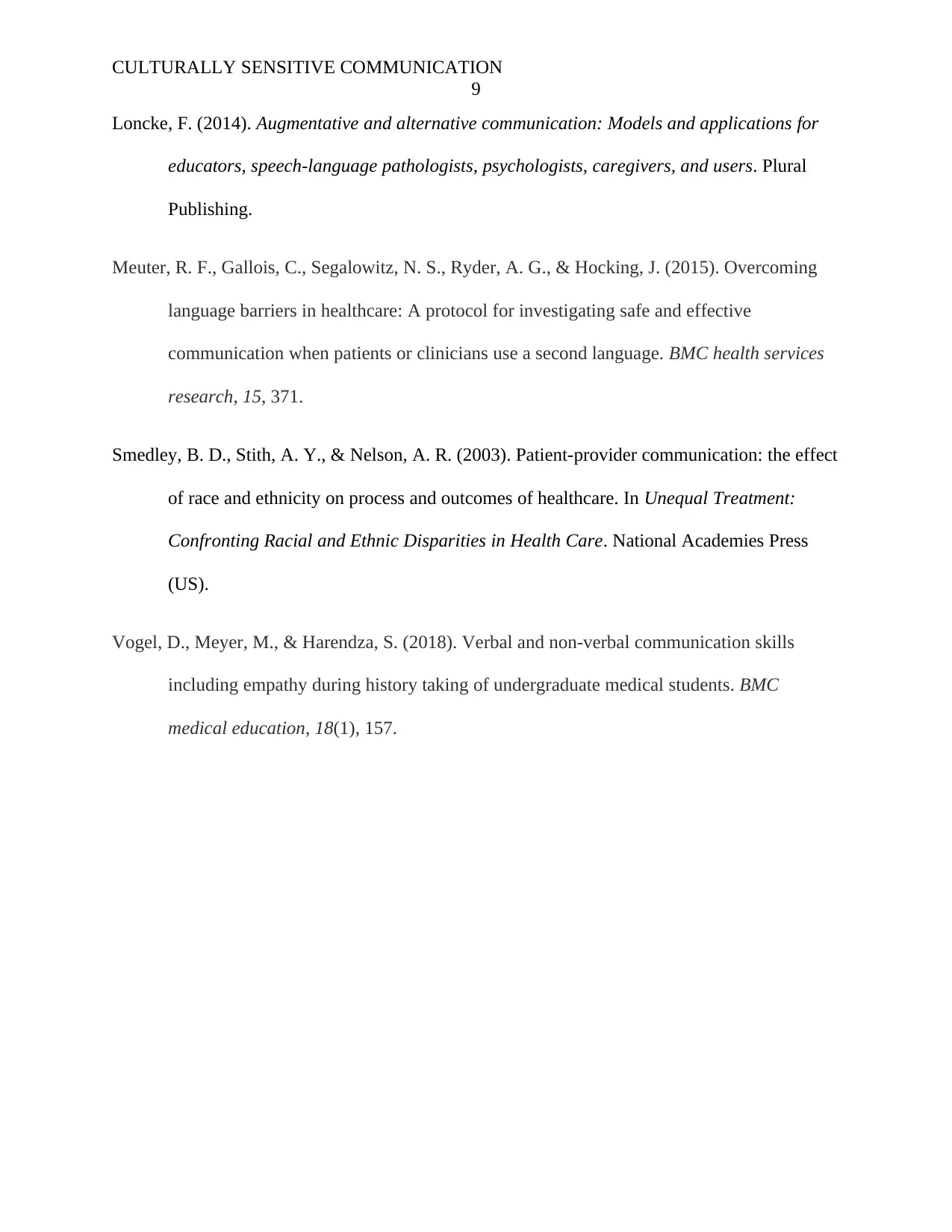
CULTURALLY SENSITIVE COMMUNICATION
9
Loncke, F. (2014). Augmentative and alternative communication: Models and applications for
educators, speech-language pathologists, psychologists, caregivers, and users. Plural
Publishing.
Meuter, R. F., Gallois, C., Segalowitz, N. S., Ryder, A. G., & Hocking, J. (2015). Overcoming
language barriers in healthcare: A protocol for investigating safe and effective
communication when patients or clinicians use a second language. BMC health services
research, 15, 371.
Smedley, B. D., Stith, A. Y., & Nelson, A. R. (2003). Patient-provider communication: the effect
of race and ethnicity on process and outcomes of healthcare. In Unequal Treatment:
Confronting Racial and Ethnic Disparities in Health Care. National Academies Press
(US).
Vogel, D., Meyer, M., & Harendza, S. (2018). Verbal and non-verbal communication skills
including empathy during history taking of undergraduate medical students. BMC
medical education, 18(1), 157.
9
Loncke, F. (2014). Augmentative and alternative communication: Models and applications for
educators, speech-language pathologists, psychologists, caregivers, and users. Plural
Publishing.
Meuter, R. F., Gallois, C., Segalowitz, N. S., Ryder, A. G., & Hocking, J. (2015). Overcoming
language barriers in healthcare: A protocol for investigating safe and effective
communication when patients or clinicians use a second language. BMC health services
research, 15, 371.
Smedley, B. D., Stith, A. Y., & Nelson, A. R. (2003). Patient-provider communication: the effect
of race and ethnicity on process and outcomes of healthcare. In Unequal Treatment:
Confronting Racial and Ethnic Disparities in Health Care. National Academies Press
(US).
Vogel, D., Meyer, M., & Harendza, S. (2018). Verbal and non-verbal communication skills
including empathy during history taking of undergraduate medical students. BMC
medical education, 18(1), 157.
⊘ This is a preview!⊘
Do you want full access?
Subscribe today to unlock all pages.

Trusted by 1+ million students worldwide
1 out of 9
Related Documents
Your All-in-One AI-Powered Toolkit for Academic Success.
+13062052269
info@desklib.com
Available 24*7 on WhatsApp / Email
![[object Object]](/_next/static/media/star-bottom.7253800d.svg)
Unlock your academic potential
Copyright © 2020–2025 A2Z Services. All Rights Reserved. Developed and managed by ZUCOL.





